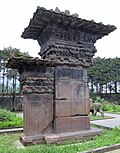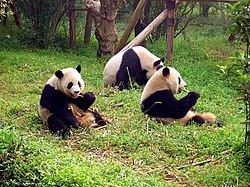Sichuan
Sichuan (Chinese: 四川; pinyin: Sì Chuān; ![]() listen (info • help)) is a province in western China with its capital at Chengdu. It is also informally called 蜀 (pinyin: Shǔ). Its Governor is Wei Hong and its CPC Ctte Secretary is Wang Dongming. With a population of 87,250,000 (2006), Sichuan is the third most populated administrative division of China. Sichuan used to be the province with the most people in China before Chongqing was separated from it, making Henan the most populous. However, when including migrants, Guangdong has more people than Henan.
listen (info • help)) is a province in western China with its capital at Chengdu. It is also informally called 蜀 (pinyin: Shǔ). Its Governor is Wei Hong and its CPC Ctte Secretary is Wang Dongming. With a population of 87,250,000 (2006), Sichuan is the third most populated administrative division of China. Sichuan used to be the province with the most people in China before Chongqing was separated from it, making Henan the most populous. However, when including migrants, Guangdong has more people than Henan.
- REDIRECT Template:See also
|
四川省 | |
|---|---|
| Name transcription(s) | |
| • Chinese | 四川省 (Sìchuān Shěng) |
| • Abbreviation | SC / 川 or 蜀 (pinyin: Chuān or Shǔ Sichuanese: Cuan1 or Su2) |
| • Sichuanese | Si4cuan1 Sen3 |
 Map showing the location of Sichuan Province | |
| Coordinates: 30°08′N 102°56′E / 30.133°N 102.933°ECoordinates: 30°08′N 102°56′E / 30.133°N 102.933°E | |
| Named for | Short for 川峡四路 Chuānxiá sì-lù literally "The Four Circuits of the Plains and Gorges", referring to the four circuits during the Song dynasty |
| Capital (and largest city) | Chengdu |
| Divisions | 21 prefectures, 181 counties, 5011 townships |
| Government | |
| • Secretary | Peng Qinghua |
| • Governor | Yin Li |
| Area | |
| • Total | 485,000 km2 (187,000 sq mi) |
| • Rank | 5th |
| Highest elevation | 7,556 m (24,790 ft) |
| Population (2013)[2] | |
| • Total | 81,100,000 |
| • Rank | 4th |
| • Density | 167.22/km2 (433.1/sq mi) |
| • Rank | 22nd |
| Demographics | |
| • Ethnic composition | Han - 95% Yi - 2.6% Tibetan - 1.5% Qiang - 0.4% |
| • Languages and dialects | Southwestern Mandarin (Sichuanese dialects), Khams Tibetan, Hakka Chinese |
| ISO 3166 code | CN-SC |
| GDP (2017) | CNY 3.70 trillion USD 547.71 billion (6th) |
| • per capita | CNY 44,651 USD 6,613 (22nd) |
| HDI (2016) | 0.780[3] (high) (23rd) |
| Website | www |
| Sichuan | |||||||||||||||||||||||||||||||||||||||
|---|---|---|---|---|---|---|---|---|---|---|---|---|---|---|---|---|---|---|---|---|---|---|---|---|---|---|---|---|---|---|---|---|---|---|---|---|---|---|---|

| |||||||||||||||||||||||||||||||||||||||
| "Sichuan" in Chinese characters | |||||||||||||||||||||||||||||||||||||||
| Chinese name | |||||||||||||||||||||||||||||||||||||||
| Chinese | 四川 | ||||||||||||||||||||||||||||||||||||||
| Postal Map | Szechwan | ||||||||||||||||||||||||||||||||||||||
| Literal meaning | "Four Rivers"[4] | ||||||||||||||||||||||||||||||||||||||
| |||||||||||||||||||||||||||||||||||||||
| Tibetan name | |||||||||||||||||||||||||||||||||||||||
| Tibetan | སི་ཁྲོན་ | ||||||||||||||||||||||||||||||||||||||
| |||||||||||||||||||||||||||||||||||||||
| Yi name | |||||||||||||||||||||||||||||||||||||||
| [[Yi language|Yi]] | ꌧꍧ syp chuo | ||||||||||||||||||||||||||||||||||||||
Name
The name 四川 (pinyin: Sì Chuān) is an abbreviation of 四川路 (pinyin: Sì Chuān Lù, translated as "Four circuits/subdivisions of rivers"), which is itself shortened from 川峡四路 (pinyin: Chuān Xiá Sì Lù, translated as "Four circuits of rivers and gorges").[1] Archived 2008-01-22 at the Wayback Machine
Subdivisions
There are 18 subdivisions within Sichuan, including both prefecture-level cities and autonomous prefectures:
People
Most people living in Sichuan are Han Chinese. There are also Tibetans, Yi people, Qiang and Naxi in the western side.
Culture
The Li Bai Memorial (located at his birthplace, Zhongba Town of northern Jiangyou County) is a museum in memory of the Chinese poet of the Tang Dynasty, Li Bai. It was prepared in 1962 on the occasion of 1,200th anniversary of his death, completed in 1981 and opened to the public in October 1982. The memorial is built in the style of the classic garden of the Tang Dynasty.
Music
Sichuan has a long history of folk and classical music. Sichuan opera is an ancient tradition that very is well-known. The Sichuan lantern drama is popular in Sichuan. The Sichuan Conservatory of Music in Chengdu is one of the oldest of musical education in China, having been established in 1939.
There is also religious music in Sichuan, played by Taoist priests in their temples.
Traditional Sichuan folk music is usually played with instruments such as the bamboo flute, pan and cymbals, gong and horn.
Food
Sichuan cuisine has an international reputation for being hot and numbing (Chinese: 麻辣), because of the common ingredient of the Sichuan peppercorn (Chinese: 花椒).
Some well-known Sichuan dishes include Kung Pao chicken (Chinese: 宮保雞丁; pinyin: Gōng Bǎo Jī Dīng) and Twice Cooked Pork (Chinese: 回鍋肉; pinyin: Huí Guō Ròu).
Language
Most dialects of the Chinese language spoken in Sichuan, including the Chengdu dialect, are similar to the dialects of neighbouring provinces Yunnan, Guizhou and Chongqing Municipality.
Sports
- Chinese Basketball Association
- Chinese Football Association Super League
- Chengdu Blades
- Chinese Volleyball League
- Sichuan Volleyball Team
- China Table Tennis Super League
- Sichuan Quan-Xing Table-Tennis Team
Universities
Tourism
UNESCO World Heritage Sites include:
- Dazu Rock Carvings - officially part of Chongqing Municipality, not Sichuan
- Huanglong, Scenic and Historic Interest Area
- Jiuzhaigou Valley, Scenic and Historic Interest Area
- Mount Emei, Scenic Area
- Leshan Giant Buddha, Scenic Area
- Mount Qincheng and Dujiangyan Irrigation System
- Sichuan Giant Panda Sanctuaries
- Daocheng Yading Airport (Highest civilian airport in the world)
Notable Sichuanese people
- Alan Dawazhouma, pop singer
- Deng Xiaoping, communist leader of China
- Jang Ri-In, pop singer
Sichuan Media
Bronze figure of a high priest from Sanxingdui, dating from the Shu kingdom
A stone-carved gate pillar, or que, 6 m (20 ft) in total height, located at the tomb of Gao Yi in Ya'an, Sichuan, built during the Eastern Han dynasty (25–220 CE)
Warlords in China around 194; Liu Bei's takeover of Yi Province meant he seized the positions of Liu Biao and Zhang Lu eventually
The Leshan Giant Buddha, built during the latter half of the Tang dynasty (618–907).
Map of Suchuen (Sichuan) from Willem and Joan Blaeu's 1659 Geographia Blaviana.
Japanese bombers bombing a road in Chongqing, then part of Sichuan province, during WW2
Giant pandas eating bamboo in Chengdu, Sichuan
A CSK-181 of the People's Armed Police Sichuan Corps
References
- ↑ "Doing Business in China - Survey". Ministry Of Commerce - People's Republic Of China. Archived from the original on 5 August 2013. Retrieved 5 August 2013.
- ↑ "Communiqué of the National Bureau of Statistics of People's Republic of China on Major Figures of the 2010 Population Census [1] (No. 2)". National Bureau of Statistics of China. 29 April 2011. Archived from the original on 27 July 2013. Retrieved 4 August 2013.
- ↑ 《2015中国人类发展报告》 (PDF) (in 中文). United Nations Development Program China. 2015. Archived from the original (PDF) on 2013-11-29. Retrieved 2014-05-14.
- ↑ An abbreviation of "the four circuits of the Rivers and Gorges" The four circuits consist of Yizhou, Lizhou, Zizhou, & Kuizhou.









